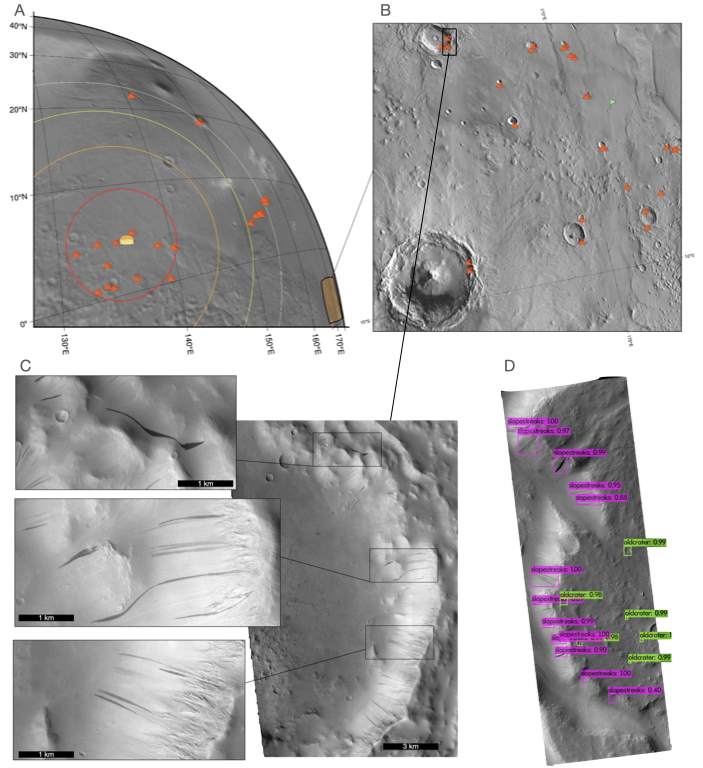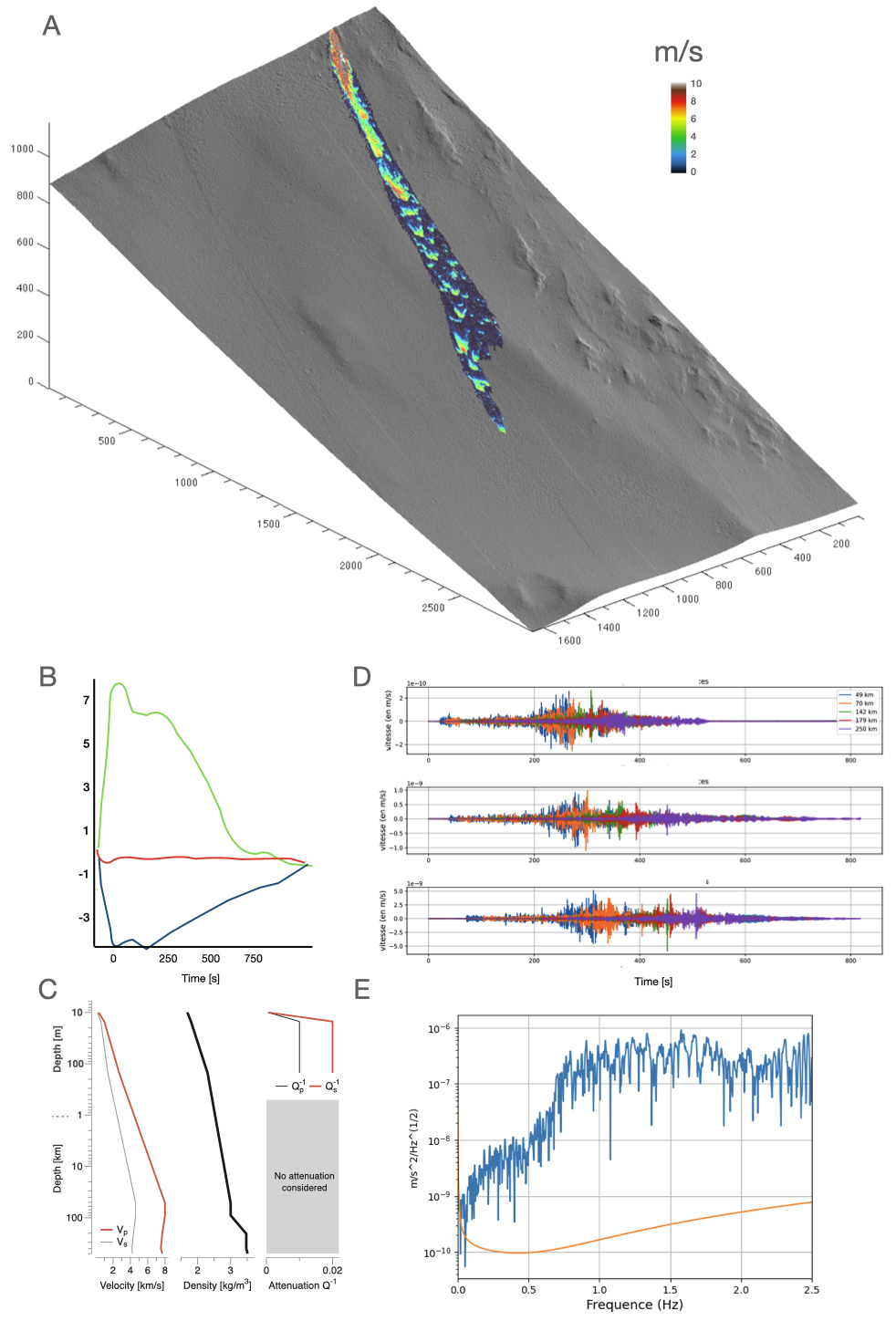InSight for seismically detectability and seismically triggered avalanches on Mars
- 1Université Paris Cité, institut de physique du globe de Paris, CNRS, Paris, France (lucas@ipgp.fr)
- 2Malin Space Science Systems, San Diego, CA, USA
- 3Brown University, Providence, RI, USA
Motivation
Granular avalanches such as slope streaks, have been observed on Mars since the beginning of the high resolution era with MOC on MGS. Such mass wasting processes are active and their dynamics has a few implications in terms of climatic conditions. However, understanding the slope streaks dynamics is still undergoing. Many authors have proposed dry spreading of fine dust or wet processes (e.g., Schorghofer et al., 2002; 2007). For instance, Head et al., (2007) have proposed spring discharge involving salty ground-water. Many of those studies have been performed from interpretations of geomorphic features by comparing knowing processes occurring on Earth and/or a few comparisons with experimental works. Consequently, a key parameter is the triggering conditions, along with the dynamical behavior of these avalanches. We hence propose a combined approach involving numerical simulations, seismology and orbital imagery in order to provide new insights.
Orbital image constraints
We investigate the orbital images from CTX and HiRISE cameras, both onboard MRO spacecraft. They provide a complete coverage of the two regions of interest being the InSight landing site (135.61ºE 4.49ºN) and the vicinity of the large quake (170.85ºE, 7.05ºS, being at 37º from the SEIS instrument) named 1222 which occurred on 5 May 2020. In both areas, we identified many past avalanche events (Figure 1-A). More specifically, we investigate the complete set of orbital data (imagery, topography, and thermo-physical properties) to estimate in particular the rate of formation of these avalanches in the vicinity of the 1222 event location (Fig. 1-B,C). This has led to request new orbital observations targeted to the most favorable areas for avalanches and hence try to link the ground acceleration resulting from the 1222 event with the triggering of new avalanches by using detection techniques (Fig. 1-D). This work, essentially observational, is combined with the following part on the detectability of this type of source by the SEIS sensor.

Figure 1 - (A) Location of identifiable landslides and avalanches (rockfall sign) around the InSight landing site (symbolized with the SEIS/WTS sign). The circles show epicentral distance from the receiver at 5º (red), 10º (orange), 15º (yellow) and 20º (light gray), which correspond to ∼300, ∼600, ∼900 and ∼1200 km respectively. Active avalanches (slope streaks) are detected at 150°E. (B) Location of active avalanches (rockfall sign) around the 1222 event location (green flag). (C) Examples of avalanches in the vicinity of the 1222 event location as seen by the CTX camera. This image was taken in May 2011 and reflects the high occurrence of such processes in the area. (D) Detection of slope streaks (and old craters) from neural networks (i.e., using darknet algorithm).
Dynamics and source function of avalanches from numerical simulations
In order to generate synthetic seismic sources due to gravity-driven sediment transport we based our simulations on a depth-averaged Saint-Venant equations model, named SHATLOP, which accounts for the curvature of the topography and on various frictional behavior for the source term following (Lucas & Mangeney, 2007; Lucas et al., 2011;2014). Volumes involved are around 8,000-40,000 m3 with a total drop height up to 1 km. The typical duration of the event is of a few minutes up to 20 minutes for a +2 km runout slope streaks, depending on the frictional law considered and small fluctuation on the bottom topography, which generates surges as shown on Fig. 2-A. The source is considered as a point force applied at the surface from the spatial integration of the avalanche resultant force, where the velocity, the resistance force, the density of the flow and the acceleration due to gravity accounting for the bottom topography curvature are all taken into account (Fig. 2-B). The velocity models are obtained after geological considerations after Pan et al., (2019), where active mass wasting processes have been identified (Fig. 2-C). Examples of resulting seismograms are shown in Fig. 2-D. The velocity model, still under investigation for Mars, is also an important open issue that has a strong impact on the resulting seismic signal. Finally, depending on source functions, velocity models, such an event may be detectable, in particular when occurring during the night at local time of the sensors, when the noise level is low and when spectral content is above SEIS sensitivity (Fig. 2-E).

Figure 2 - (A) Example numerical simulation of a martian dust avalanche over a DTM generated from HiRISE stereo pair (Color scales with the velocity). (B) Resulting source force history. (C) Example of a velocity and attenuation model for Mars. (D) Synthetic seismograms accounting source distance for various velocity models and epicentral distances. (E) ADS example for a small event at 140 km.
References
Head, J., Marchant, D., Dickson, J.,Levy, J., Morgan, G. Slope streaks in the Antarctic Dry Valleys: Characteristics, candidate formation mechanisms, and implications for slope streak formation in the Martian environment. 7 th International Conf. (2007)
Lucas A., and A. Mangeney. “Mobility and topographic effects for large Valles Marineris landslides on Mars”. In: Geophys. Res. Lett., 34, L10201 (2007)
Lucas A., et al. “Influence of the scar geometry on landslide dy-namics and deposits: Application to Martian landslides”. In: J. Geophys. Res. - Planets, 116, E10001 (2011)
Lucas, A., A. Mangeney, and J-P. Ampuero. “Frictional velocity-weakening in landslides on Earth and on other planetary bodies”. In: Nature Comm.,5:3417 (2014)
Pan L., et al. “Crust stratigraphy and heterogeneities of the first kilometers at the dichotomy boundary in western Elysium Planitia and implications for InSight lander”. In: Icarus (2019)
Schorghofer N., Aharonson O., and Khatiwala S. “Slope streaks on Mars: Correlations with surface properties and the potential role of water”. In: Geophys. Res. Lett.,29(23) (2002)
Schorghofer, N., Aharonson, O., Gerstell, M. & Tatsumi, L. Three decades of slope streak activity on Mars. Icarus. 191. 132-140 (2007)
How to cite: Lucas, A., Bourdon, L., Mangeney, A., Sainton, G., Bah, M. A., Tawamura, T., Lognonné, P., Rodriguez, S., Posiolova, L., Daubar, I., and malin, M.: InSight for seismically detectability and seismically triggered avalanches on Mars, Europlanet Science Congress 2022, Granada, Spain, 18–23 Sep 2022, EPSC2022-366, https://doi.org/10.5194/epsc2022-366, 2022.

